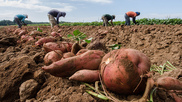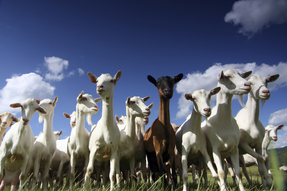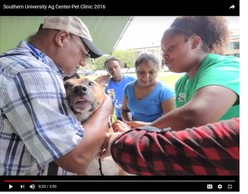Success Stories
Celebrating our nation’s 1890s land-grant universities
On Aug. 30, 1890, the
Second Morrill Act was signed into law, creating our nation’s historically
black land-grant universities (LGU).
Today, our nation’s 1890
land-grant universities are a thriving network of 19 universities with a legacy
of educating first-generation and economically disadvantaged college students;
enhancing the resilience of limited-resourced farmers, families, individuals,
and underserved communities; and conducting cutting-edge research to
generate new knowledge and solutions to address local, regional, and global
challenges. We celebrate the anniversary of the 1890s land grant universities by highlighting
the user-inspired NIFA-supported research, education, and extension projects
below.
 Build a better robot
Unmanned agricultural
robots systems (UARS) are increasingly used in contemporary precision
agriculture. To help foster a diverse and qualified workforce in ag technology,
Prairie View A&M University (PVAMU) developed a special topic class for engineering
technology students. Students designed, constructed, and operated a UARS in the
classroom and in the field. The UARS included various sensors to measure crop
height, crop canopy, and various properties of crops and soils. Students tested the UARS in rice and fruit
fields.
NIFA supported this research
through the 1890 Capacity Building grant.
Read about Prairie
View A & M’s research. Image provided by USDA.
|
 A
tasty tuber for the first state
The sweet potato is an
inexpensive, nutritious source of carbohydrates and vitamins. While Louisiana
and North Carolina are the largest U.S. producers of the tasty tuber,
researchers at Delaware State University are looking to breed varieties
that will thrive in the state’s unique climate and soil. The research team
tested four varieties with distinct skin color, flesh color, and taste.
All four did well during the 120-day growing period. The research could lead to
new, low-cost produce options for low-income residents in the state.
NIFA
supports this research through Evans-Allen funding.
Learn more about the Delaware State University research. Image provided by Lance Cheung, USDA.
|
News Coverage
 Goats
and sheep versus barber pole worms
Gastrointestinal
nematodes (GIN), aka barber pole worms, can affect sheep and goats with low
weight gain, anemia, and even death.
These health conditions can result in millions in losses for farmers. Since
2003, Fort
Valley State University has led the American Consortium for Small Ruminant
Parasite Control (ACSRPC) to conduct producer-oriented research and outreach
programs to control GIN in small ruminants and educate stakeholders on the
latest treatment approaches.
Through ACSRPC, farmers
have greatly improved the sustainability of their sheep and goat production
systems through Targeted Selective Treatment, in which only the animals in the
herd or flock that actually need treatment are identified and treated for GIN
infection.
The research has allowed farmers to
save money by reducing on-farm use of synthetic drugs by up to 90 percent
($150-$200 per 100 animals per year for reduced drug use) and by identifying
and retaining parasite-resistant breeding stock.
This project was supported
by the Sustainable Agriculture Research and Education (SARE) program, 1890
Institution Capacity Building Grant, NIFA Organic Research and Education
Initiative, and the Small Business Innovation Research (SBIR) program.
Read more about the Fort
Valley State University research. Image provided by iStock.
|
The Library
 Waste not, want not
Poultry farms produce 10
million tons of waste per year in the United States. This waste has value as a
fertilizer and as a potential alternative energy source.
Researchers at West
Virginia State University (WVU) are investigating how to use anaerobic
digestion to treat and use organic wastes from animal farms, agriculture and
industry. Anaerobic digestion (AD) facilities use naturally occurring
microorganisms to turn biodegradable materials into energy or
fertilizer.
The research has led to
increased bioenergy production from anaerobic digestion, the development of new
AD technology, and reduced farm pollution draining into the Potomac River.
NIFA supports the research
project through Evans-Allen and 1890 Capacity Building grant funds.
Read more on WVU’s research.
Image provided by iStock.
|
Video
 Man’s
best friend in times of need
The Southern University Ag Center in Baton
Rouge, Louisiana has a strong animal science program that can translate from
livestock treatment to community pet care in times of need.
Following
the catastrophic Louisiana flooding in 2016, the Ag Center offered a free
clinic to pet owners in the Baton Rouge and surrounding areas. Students,
faculty, staff, and volunteers provided vaccinations, heartworm treatment,
identity chip insertions, and general advice to concerned pet owners. The
clinic treated more than 200 cats and dogs.
“Part
of what we do is service the community.
Our extension service gives us our statewide mission.” said Dr. Bobby
Phills, chancellor of Southern University Ag Center, dean of the College of
Agriculture.
NIFA supports the program through Agricultural
Extension at 1890 Land-Grant Institutions.
Watch
the video on the Southern
University Ag Center clinic. Image provided by Southern University Ag Center.
|
Tweet of the Week
#NIFAIMPACTS
|